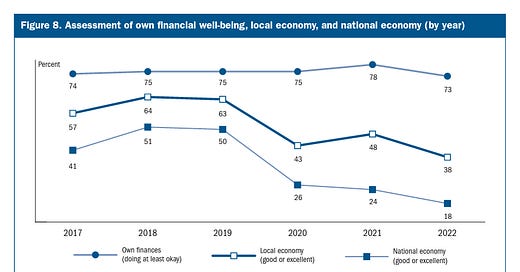Weekly Good Reads: 5-1-1
Debt Talk Relief, Maths Teacher AI Message, India and China, Dunning Kruger
Welcome to another issue of 5-1-1! I am Marianne O, writer of The Learner’s Mind on investing, economy, and wellness ideas. In this weekly, I will include 3 links to relevant economic and investment news, 1 link to finance, and 1 to wellness/idea pursuit based on what I read (5 links). I will also include 1 important chart and 1 investment term to know. You can easily subscribe to my newsletter by clicking below.
Market and Data Comments
U.S. debt-limit talks progress on Thursday and Friday and the momentum on chip stock Nvidia Corp based on positive earnings induced by its data centre and AI strategy has propped up the S&P 500 by 0.32% this week. Treasury Secretary Yellen also pushed back the deadline for the U.S. debt payments can be fully met to June 5 (the X-date).
The IMF concluded its Article IV consultation (its assessment of countries’ economic and financial developments) on the U.S. and warned the U.S. should immediately raise the debt limit or suspend the debt cap.
The IMF sees the U.S. inflation rate above the Fed’s 2% medium-term target throughout 2024 and the interest rate will remain at 5.25% to 5.5% until late 2024. This coincided with the recent release of the core PCE index in the U.S., which climbed 4.4% yoy (faster than expected or desired by the Fed) in April compared to 4.2% in March. The panacea for inflation depends on understanding the sources of inflation as
mentioned in her recent piece: “Inflation: it's "complicated".Looking to China, the domestic shares (A-share) have given up half of their gain since the “reopening trade” that started in November 2022 - from up 20% to now up 10%. Industrial production and consumption-driven recovery were poorer than expected.
While China’s GDP is still expected to reach the government target of 5% in 2023, local government debt load and the debt woes of real estate developers are the main dampers on Chinese growth. More detailed reporting can be seen in
April economic report for China.There has been economic optimism about the Indian economy. The United Nations recently estimated India is the most populous country, overtaking China by 3 million people by mid-2023. Nearly 80% of India’s population is younger than 50 compared to fewer than two-thirds in China.
While China’s growth may not outperform this year, the piece below discussed some important differences between China's and India's economic development - the major one being India’s absence of revolution “that left in place existing power structures and long-standing vested interests, along with the corruption they nurtured, blocking the radical political or economic changes that turbocharged China’s economic growth from the late 1970s.”
India can grow differently, however, especially since services are now a big part (about 52%) of the economy, and chip manufacturing and the wide adoption of the internet will propel the economy faster.
Economy and Investments:
David Rosenberg: This AI Boom Has Echoes of the Dotcom Bubble (Financial Post)
IMF Urges US to Raise or Suspend Debt Cap, Says Risk Avoidable (Bloomberg or read here)
Why India Will Continue to Lag Behind China as a Global Economic Power (SCMP)
Finance/Wealth:
The First Rule of Dunning Kruger… (The Big Picture) - the bottom line: The first rule of Dunning Kruger club is that you do not know you are in Dunning Kruger club…and this, unfortunately, contributes most to flaws in investment behaviour.
Wellness/Idea:
Bonus: Automated Morningness-Eveningness Questionnaire (AutoMEQ) - I find it surprisingly accurate.
One Chart You Should Not Miss: Assessment of own financial well-being, local economy, and national economy (by year)
- extracted from the Economic Well-Being of U.S. Households in 2022 (Federal Reserve)
The Federal Reserve has just published its annual report on the U.S. households’ economic well-being in areas including income, employment, expenses, housing, banking and credit, and retirement and savings.
From the chart below, 73% of U.S. adults were doing at least okay financially, sharply down by 5% from 2021 and was the lowest seen since 2016. More alarmingly, the gap between people’s perception of their financial well-being and the national economy has more than doubled since 2018 (from 24% in 2018 to 55% in 2022). Despite a still good labour market and slowly declining inflation, the financial mood in the U.S. is not sunny.
One Term to Know: Index ETFs
Many have heard about Exchange Traded Fund (ETF), which tracks an underlying basket of securities (stocks, bonds, commodities, currencies, etc.).
Often these ETFs track an index such as the S&P 500 in the U.S. (the ticker is SPY). SPY is the largest ETF in the world with underlying assets under management (AUM) of about $390 billion currently. Based on the past three months’ data, almost 90 million shares of SPY trade in a day. Index ETFs are typically called passive investments as they mimic the composition of an underlying index.
ETFs can also be actively managed. Mutual fund companies have especially been active in launching active ETFs to win more business as the popularity of ETFs has risen dramatically in the past ten years, attracting fund inflows at the expense of mutual funds. There are now over 11,000 ETF products globally.
Some differences between an index ETF and a mutual fund are (1) ETF trades like a stock during the open market hours while mutual fund trades once a day (2) ETF is more tax efficient than mutual funds (3) ETF is often used by investors and fund managers to get exposure of (or get out of ) a sector/theme/asset class nimbly.
Learn more about their differences in the following article:
Please do not hesitate to get in touch if any questions! If you like this weekly, please share or subscribe to my newsletter.



